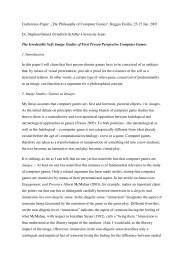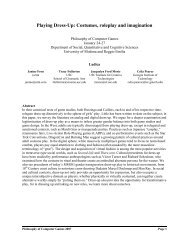Since all perceptual experience regarding external states of <strong>the</strong> world is embodied, orif you like, bodily mediated experience, so too, is perceptual experience of our owninternal states generated by biochemical <strong>and</strong> biophysical characteristics of our bodies.This means that <strong>the</strong> relative saliency of, <strong>and</strong> thus <strong>the</strong> meanings of, linguistic terms forspecific types of actions like ‘running fast’, ‘walking slowly’, ‘jumping up <strong>and</strong> down’etc. can only be described by reference to non-linguistic dimensions of perceptualexperience associated with <strong>the</strong> bodily mediation of our performance of each of <strong>the</strong>seactions in <strong>the</strong> various contexts in which <strong>the</strong>y are carried out. Moving up one level ofgenerality, it is also clear <strong>the</strong> more general meanings associated with linguistic termsfor types of motion structured in certain configurations which constitute <strong>the</strong> broadergrained “fingerprints” or identifying characteristics of each of <strong>the</strong> specific forms ofaction mentioned above (for example ‘rapid, fluid forward motion of <strong>the</strong> bodyinvolving <strong>the</strong> iterative use of both legs’, in <strong>the</strong> case of ‘running fast’, are associatedwith o<strong>the</strong>r non-linguistic dimensions of <strong>the</strong>se same perceptual experiences.In support of <strong>the</strong> above <strong>the</strong>sis, it is also relevant to mention in this connection acomprehensive series of work on movement, embodiment, experience <strong>and</strong> <strong>the</strong> originsof language <strong>and</strong> meaning by Maxine Sheets-Johnstone. In her book: The Primacy ofMovement (1999) <strong>and</strong> o<strong>the</strong>r works, she forcefully argues for <strong>the</strong> need to developbetter underst<strong>and</strong>ings of what she refers to as “thinking in movement”, claiming thatall human thought <strong>and</strong> language is rooted in “corporeal matters of fact”, constantlypresent in “tactile-kines<strong>the</strong>tic experience”. In her own words:“The generative sources of fundamental human (hominid) concepts are data -- that is,corporeal matters of fact – that are sensuously present in tactile-kines<strong>the</strong>tic experience. Hence<strong>the</strong> issue is not "abstract" concepts […] or modality dominance; it is a question of conceptsconcretely grounded in everyday human (hominid) experience.” 18In The Primacy of Movement, she analyses <strong>the</strong> experience of thinking in movement inimprovisational dance in terms of how both thinking <strong>and</strong> movement are aspects ofkinetic bodily logos attuned to an evolving dynamic situation. Thinking in movement,she claims, “involves no symbolic counters, but is tied to an on-going qualitativelyexperienced dynamic in which movement possibilities arise <strong>and</strong> dissolve.” Thiscorresponds well, she continues elsewhere in <strong>the</strong> same volume, with psychologicalstudies which show that <strong>the</strong> first concepts of infants are tied to dynamic events, orkinetic happenings. Prior to children’s ingression into <strong>the</strong> world of language, <strong>the</strong>conceptions of <strong>the</strong> world are grounded in <strong>the</strong>ir experiences of <strong>the</strong>ir own body inmovement, <strong>and</strong> <strong>the</strong> movement of o<strong>the</strong>r bodies in <strong>the</strong> surrounding environment. Childpsychologist Jerome Bruner’s (1990) work on children’s development, she notes, alsoaffirms a similar <strong>the</strong>sis, namely that <strong>the</strong> principal interest of infants centres onagentivity <strong>and</strong> action, while <strong>the</strong> work of infant psychologist <strong>and</strong> psychiatrist DanielStern (1981) has confirmed that certain kinds of non-verbal behaviours (gaze, headorientation, spatial positioning, posture <strong>and</strong> distance assumption) function from <strong>the</strong>very beginning of life as biologically contingent presuppositions for communication.Such non-verbal behaviours are not transformed, or transformable into language, butcontinue to operate in t<strong>and</strong>em with it in meaning-making, communicational activities.18 From an online discussion on <strong>the</strong> Psycoloquy mailing list, September 1994:http://www.ai.univie.ac.at/archives/Psycoloquy/1994.V5/0082.htmlSee also Sheets-Johnstone 1990, 1994, 1999.
4. <strong>Mind</strong> in nature <strong>and</strong> nature in mindSo having made that brief excursion into <strong>the</strong> realms of motion, action <strong>and</strong> experience,let us now go back, <strong>and</strong> on, to look at yet ano<strong>the</strong>r possibly relevant quote from <strong>Peirce</strong>:“To begin with <strong>the</strong> psychologists have not yet made it clear what <strong>Mind</strong> is. I do not mean itssubstratum; but <strong>the</strong>y have not even made it clear what a psychical phenomenon is. [...] But Ido not believe that psychology can be set to rights until <strong>the</strong> importance of Hartmann'sargument is acknowledged, <strong>and</strong> it is seen that feeling is nothing but <strong>the</strong> inward aspect ofthings, while mind on <strong>the</strong> contrary is essentially an external phenomenon. The error is verymuch like that which was so long prevalent that an electrical current moved through <strong>the</strong>metallic wire; while it is now known that that is just <strong>the</strong> only place from which it is cut off,being wholly external to <strong>the</strong> wire.” [CP 7. 364]Here <strong>Peirce</strong> is certainly referring initially to Eduard von Hartmann’s (1842-1906),notion that “observable” phenomena such as “instinct” or “impulse” in animals couldbe scientifically interpreted as evidence that nature possesses “will”. At <strong>the</strong> time when<strong>Peirce</strong> wrote <strong>the</strong> piece above, von Hartmann’s ideas represented a contemporaryinterpretation of Schopenhauer’s (1788-1860) earlier metaphysical system ofvoluntarism, where unconscious will is seen as <strong>the</strong> main active principle in nature,<strong>and</strong> as that which “enables” or “activates” human intelligence, which is seen as a sortof by-product of <strong>the</strong> “natural organization” of <strong>the</strong> brain (c.f. Baldwin, 1913).But one of <strong>the</strong> main points <strong>Peirce</strong> seems to have wanted to make here is that <strong>the</strong>moment-to-moment flow of immediate sense impressions (for which he makes use ofhere, as he often does elsewhere, <strong>the</strong> term “feeling”), <strong>and</strong> <strong>the</strong> way in which our minds“organise” this flow of sense impressions into complex sign relations that areembodied through semiosis – which we generally seek to underst<strong>and</strong> today in terms ofgeneral perception processes <strong>and</strong> systems of knowledge <strong>and</strong>/or belief organisation 19 –depend, when all comes to all, on more general dynamic, self-organizing relationalprinciples to which <strong>the</strong> entire sensible <strong>and</strong> non-sensible “external” reality in which welive is also subject. Viewed from this perspective, mind is, as <strong>Peirce</strong> puts it,“essentially an external phenomenon”, since, from his point of view, mind is just asmuch present in <strong>the</strong> relational complexities of <strong>the</strong> self-organizing sign processes innature <strong>and</strong> culture which give life, growth of diversity <strong>and</strong> materiality to our“external” environment, as it is in <strong>the</strong> complex systems of sign relations which reflect“private”, perspectivised aspects of this environment as “embodied” in each of ourindividual mind-body complexes.The creative metaphor <strong>Peirce</strong> uses to evoke this idea in <strong>the</strong> text fragment cited aboveis taken from physical science, namely that of <strong>and</strong> electrical current flowing “in” awire. In doing so, he reconceptualizes <strong>the</strong> energy gradient we popularly refer to as“current”, as merely “localised” or “focussed” within a certain type of bounded“hereness <strong>and</strong> nowness” represented by <strong>the</strong> wire. The current we conceive of as“moved through <strong>the</strong> wire” has in his view merely been “cut off” from a widercontinuity of potential (energy) which is in constant flux <strong>and</strong> “wholly external” to <strong>the</strong>“embodied” (or embodying) actuality of <strong>the</strong> wire in question. This particularmetaphor is ra<strong>the</strong>r useful since it challenges us to actively consider whe<strong>the</strong>r or not <strong>the</strong>continuity of sensory processes (or flows of signs, if we accept <strong>Peirce</strong>’s dictum that“all thought is in signs”) in <strong>the</strong> phenomenal experience we often call “mind”, may insome way or o<strong>the</strong>r be continuous with similar semiosic processes occurrent in nature.19 For discussion of some semiotic models of knowledge organization, see for example Thellefsen, 2002
- Page 1 and 2: Università degli Studi di Modena e
- Page 3 and 4: merely as a result of those words w
- Page 5 and 6: “The question is what the phenome
- Page 7 and 8: somewhat equivalent to the seven or
- Page 9 and 10: and in doing so, dampen the effects
- Page 11 and 12: tumbleweeds will not generally be a
- Page 13: organised, evaluated, elaborated an
- Page 17 and 18: development of modern IA (Intellige
- Page 19 and 20: norms regarding communication, acti
- Page 21 and 22: dissipative systems, chaotic change
- Page 23 and 24: ThirdnessIOSecondnessMindWorld/ Rea
- Page 25 and 26: ReferencesAamodt, Anders & Komorows
- Page 27 and 28: Feibleman, James K.1946 An Introduc
- Page 29 and 30: Rodda, M. & Grove, C.1987 Language,






